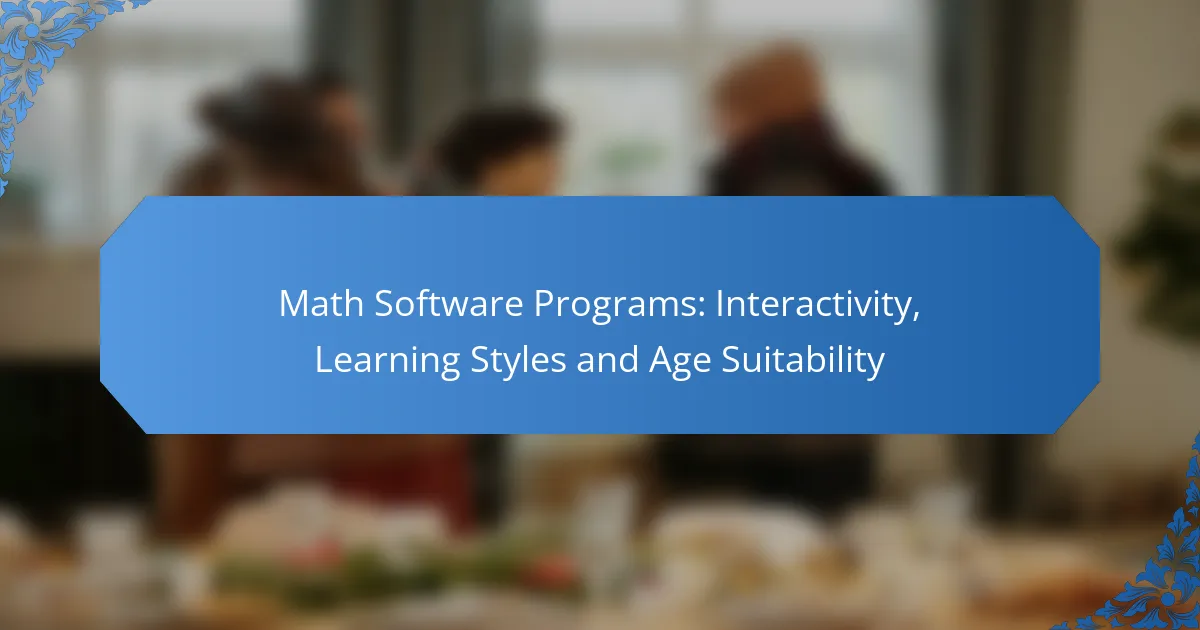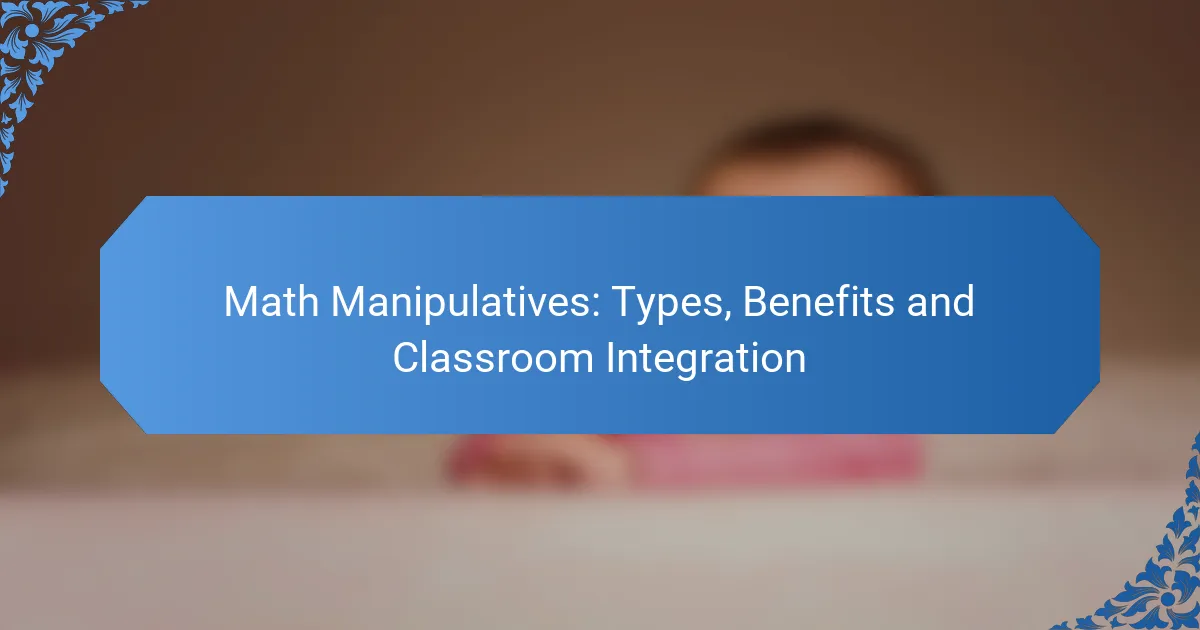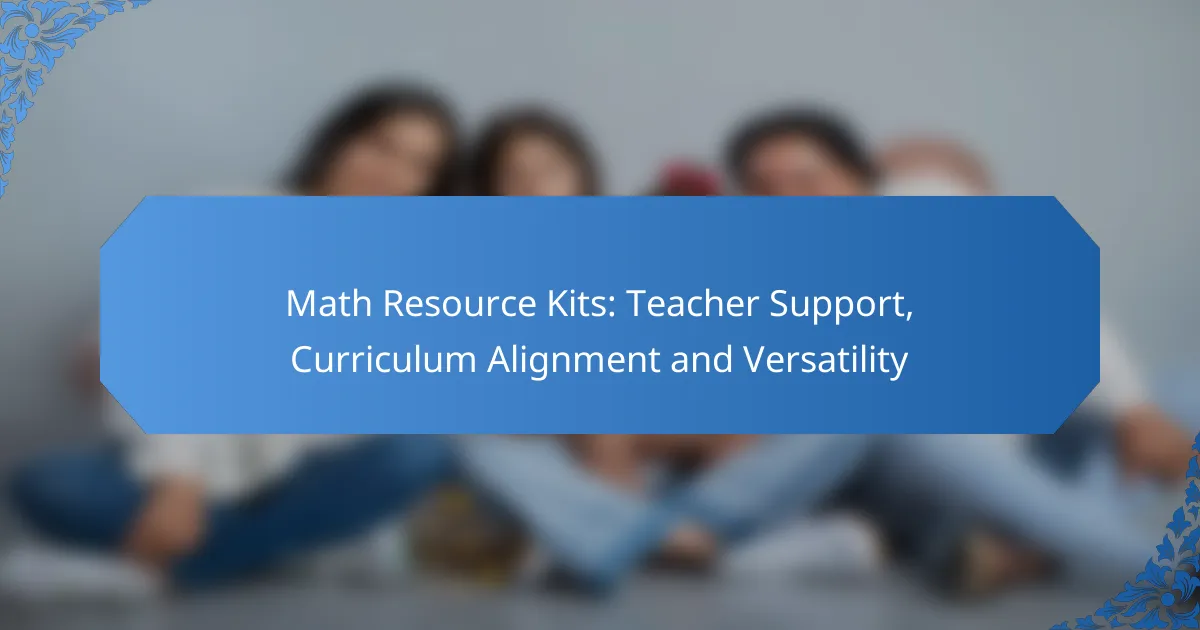Math software programs designed for interactivity play a crucial role in enhancing the learning experience by allowing users to engage with mathematical concepts through dynamic visualizations and hands-on activities. These programs cater to diverse learning styles and age groups, making math more accessible and enjoyable for everyone. By understanding individual preferences in information absorption, educators and learners can select software that maximizes engagement and retention across different age demographics.
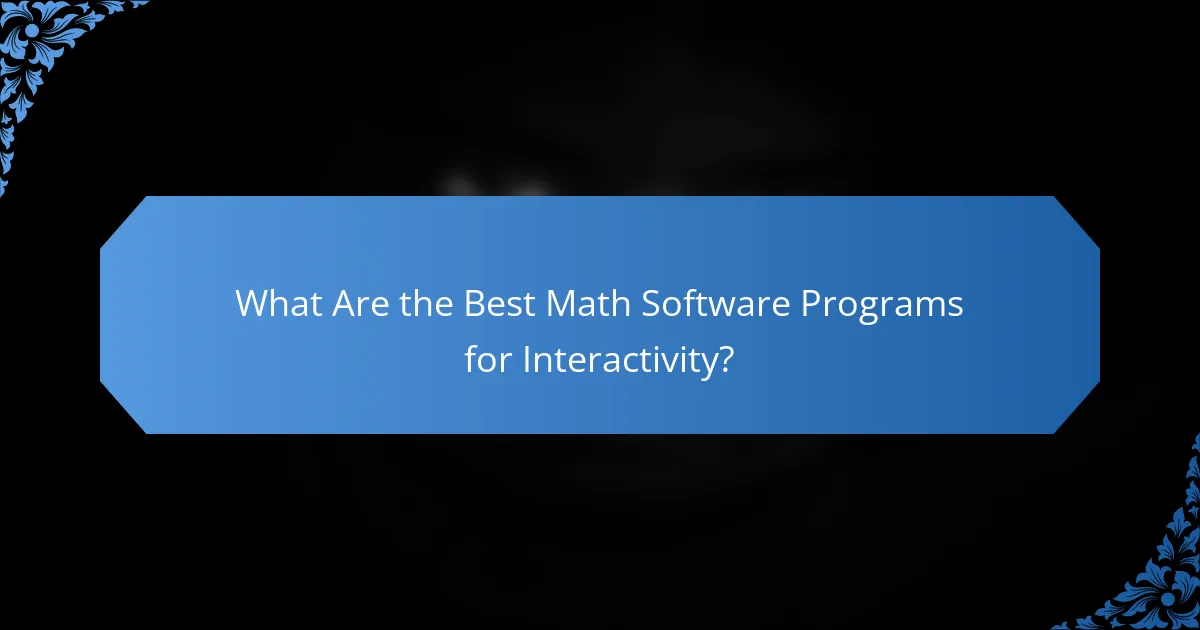
What Are the Best Math Software Programs for Interactivity?
The best math software programs for interactivity enhance learning by allowing users to engage with mathematical concepts through dynamic visualizations and hands-on activities. These tools cater to various learning styles and age groups, making math more accessible and enjoyable.
GeoGebra
GeoGebra is a free, interactive geometry, algebra, and calculus software that combines multiple mathematical disciplines into one platform. It allows users to create constructions and models, making it ideal for visual learners who benefit from seeing concepts in action.
With features like drag-and-drop functionality and real-time graphing, GeoGebra is suitable for students of all ages, from elementary school to university level. It also supports collaborative learning, enabling students to work together on projects and share their findings.
Desmos
Desmos is an online graphing calculator that offers a user-friendly interface for plotting functions and exploring algebraic concepts. Its interactive features allow users to manipulate equations and instantly see the results, which is particularly helpful for kinesthetic learners.
Desmos is widely used in classrooms and is suitable for middle school through high school students. It also provides a range of activities and lessons that cater to different learning styles, making it a versatile tool for math education.
Mathway
Mathway is a problem-solving app that provides step-by-step solutions for a wide range of math problems, from basic arithmetic to advanced calculus. It is particularly useful for students who need immediate assistance with homework or exam preparation.
While Mathway is great for individual learning, users should be cautious not to rely solely on it for understanding concepts. It’s best used as a supplementary tool alongside traditional study methods to reinforce learning.
Microsoft Math Solver
Microsoft Math Solver is an app that allows users to scan or type math problems and receive instant solutions along with explanations. This tool is designed for learners of all ages and is particularly beneficial for those who prefer visual aids and step-by-step guidance.
In addition to solving problems, Microsoft Math Solver offers practice problems and video tutorials, making it a comprehensive resource for students looking to improve their math skills. Users should ensure they engage with the explanations provided to enhance their understanding.
Wolfram Alpha
Wolfram Alpha is a computational knowledge engine that can solve complex mathematical queries and provide detailed explanations. It is particularly useful for higher education students and professionals who require in-depth analysis and data interpretation.
While Wolfram Alpha is powerful, users should be aware that it may not always provide step-by-step solutions for every problem. It is best used as a research tool or for verifying results rather than as a primary learning resource.

How Do Learning Styles Affect Math Software Selection?
Learning styles significantly influence the selection of math software, as different programs cater to various preferences in how individuals absorb information. Understanding whether a learner is visual, auditory, or kinesthetic can help in choosing software that enhances engagement and retention.
Visual Learners
Visual learners benefit from math software that incorporates graphics, diagrams, and color-coded elements. Programs that use visual representations of concepts, such as charts or animated sequences, can help these learners grasp abstract ideas more easily.
When selecting software for visual learners, look for features like interactive graphs, visual problem-solving tools, and video tutorials. Examples include programs that allow users to manipulate shapes or visualize equations in real-time, which can enhance understanding.
Auditory Learners
Auditory learners thrive with math software that includes verbal explanations, sound cues, and interactive dialogues. These learners often grasp concepts better when they can hear instructions or explanations rather than just reading text.
Choose software that offers audio feedback, spoken instructions, or discussion prompts. Programs that incorporate podcasts or video lessons with narration can be particularly effective for auditory learners, making complex topics more accessible.
Kinesthetic Learners
Kinesthetic learners require hands-on interaction with math concepts to fully engage. Software that allows for tactile involvement, such as drag-and-drop features or simulations, can be particularly beneficial for these learners.
Look for programs that include interactive activities, such as building models or solving problems through physical manipulation of elements. This approach not only keeps kinesthetic learners engaged but also reinforces their understanding through active participation.
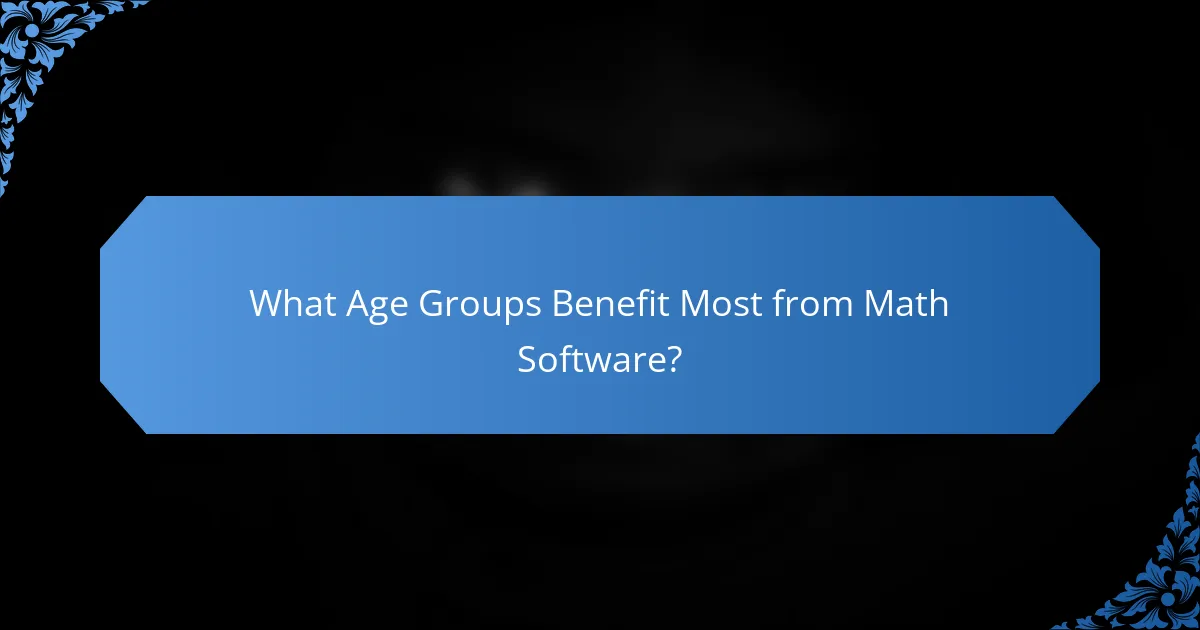
What Age Groups Benefit Most from Math Software?
Math software is particularly beneficial for students across various age groups, enhancing their understanding and engagement with mathematical concepts. Each age group has unique learning needs that can be effectively addressed through tailored software features.
Elementary Students
Elementary students, typically aged 5 to 11, benefit greatly from math software that incorporates interactive elements and visual aids. Programs designed for this age group often use games and colorful graphics to make learning enjoyable and engaging.
Key features to look for include adaptive learning paths that adjust to the child’s pace and progress tracking for parents. For example, software that rewards achievements with badges can motivate young learners to practice more.
Middle School Students
Middle school students, aged 11 to 14, require math software that challenges them while still being accessible. This age group often faces a transition to more abstract concepts, so programs that provide real-world applications of math can be particularly effective.
Look for software that includes problem-solving scenarios and collaborative tools, allowing students to work together on projects. Features like step-by-step tutorials can help clarify complex topics such as algebra and geometry.
High School Students
High school students, generally aged 14 to 18, benefit from math software that prepares them for advanced topics and standardized tests. Programs that offer practice exams and detailed feedback on performance are essential for this age group.
Consider software that aligns with curriculum standards and includes resources for calculus, statistics, and test preparation. Additionally, tools that allow for graphing and modeling can help students visualize concepts and enhance their analytical skills.
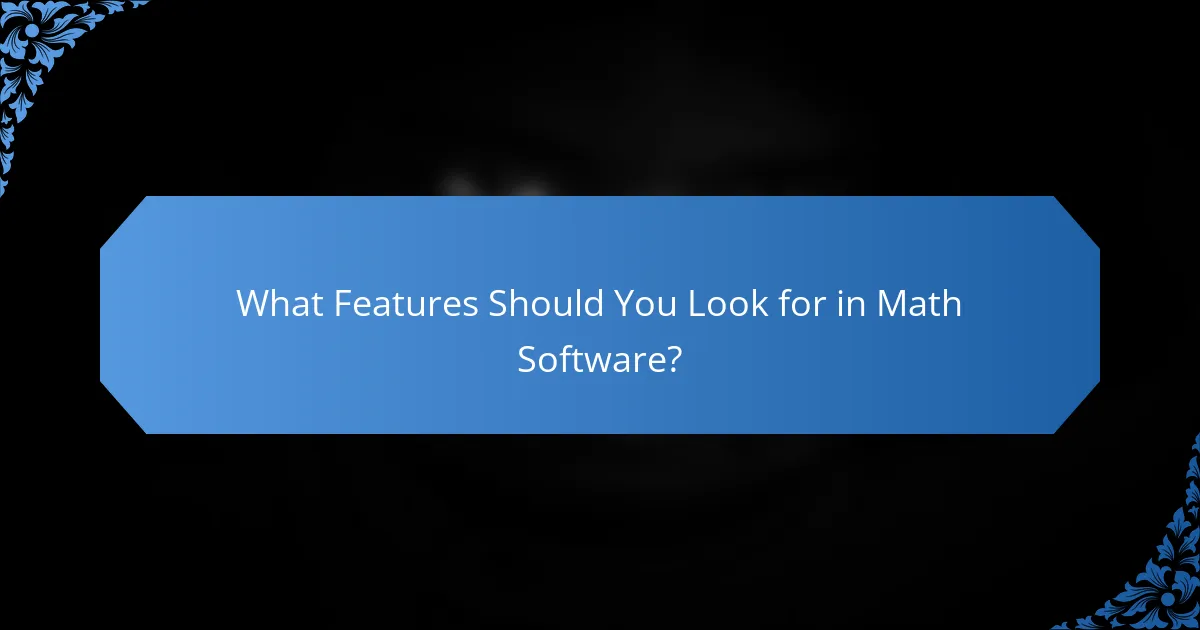
What Features Should You Look for in Math Software?
When selecting math software, prioritize features that enhance user engagement and facilitate learning. Key aspects include a user-friendly interface, interactive tools, customization options, and effective progress tracking.
User Interface
A clear and intuitive user interface is essential for math software, especially for younger users or those with varying learning styles. Look for software that uses simple navigation, visually appealing layouts, and clear instructions to minimize frustration.
Consider options that offer adjustable font sizes, color schemes, and layout designs to accommodate different preferences. A well-designed interface can significantly improve the learning experience and encourage consistent use.
Interactive Tools
Interactive tools are crucial for engaging users and enhancing comprehension. Features such as drag-and-drop activities, virtual manipulatives, and interactive quizzes can make learning math concepts more dynamic and enjoyable.
Choose software that allows users to explore mathematical concepts through hands-on activities. This approach can cater to various learning styles, making it easier for students to grasp complex ideas through practice and experimentation.
Customization Options
Customization options enable users to tailor the learning experience to their individual needs. Look for software that allows adjustments in difficulty levels, content focus, and pacing to suit different learners, whether they are beginners or advanced students.
Additionally, the ability to create personalized learning paths can help maintain motivation and ensure that users are challenged appropriately. This flexibility is particularly beneficial in diverse classroom settings or for self-directed learners.
Progress Tracking
Effective progress tracking features help users monitor their learning journey and identify areas for improvement. Look for software that provides detailed reports on performance, including scores, time spent on tasks, and mastery of specific skills.
Consider tools that offer visual representations of progress, such as graphs or badges, to motivate learners. Regular feedback can guide users in setting goals and adjusting their study habits, ultimately enhancing their overall math proficiency.

How Do Math Software Programs Support Different Learning Styles?
Math software programs cater to various learning styles by incorporating features that engage visual, auditory, and kinesthetic learners. These programs utilize interactive elements and personalized approaches to enhance understanding and retention of mathematical concepts.
Adaptive Learning Technologies
Adaptive learning technologies adjust the difficulty and type of content based on a learner’s performance. This personalized approach ensures that students receive appropriate challenges, which can help maintain engagement and prevent frustration. For instance, if a student struggles with basic algebra, the software may provide additional practice problems tailored to their skill level.
These technologies often use algorithms to analyze user interactions and adapt in real-time. This means that as learners progress, the software can shift focus to more advanced topics or revisit foundational concepts as needed. Schools and educational institutions may find that implementing such systems can lead to improved student outcomes.
Gamification Elements
Gamification elements in math software programs make learning more engaging by incorporating game-like features such as points, badges, and leaderboards. These elements motivate students to complete tasks and challenge themselves, fostering a competitive yet supportive learning environment. For example, a program might reward students with points for completing exercises or achieving high scores on quizzes.
Incorporating gamification can enhance retention and make complex topics more approachable. However, it’s essential to balance game mechanics with educational content to ensure that the focus remains on learning. Educators should monitor student engagement and adjust the level of gamification to suit different age groups and learning styles effectively.

What Are the Costs Associated with Math Software Programs?
The costs of math software programs can vary widely based on features, licensing models, and user needs. Typically, expenses can range from free options to several hundred dollars per user annually, depending on the complexity and support offered.
Initial Purchase or Subscription Fees
Math software programs often require either a one-time purchase or a subscription fee. One-time purchases can range from around $50 to $300, while subscriptions may cost between $10 to $50 per month. Consider the long-term value and updates provided with subscriptions when making a decision.
Additional Costs for Features and Upgrades
Many math software programs offer basic versions at lower prices, but advanced features may come with additional costs. These can include premium content, specialized tools, or enhanced support services. Users should evaluate their needs to avoid unnecessary expenses on features that may not be utilized.
Hardware and System Requirements
Some math software may require specific hardware or operating systems, which can lead to additional costs. Ensure your devices meet the software’s requirements to avoid unexpected expenses on upgrades or new equipment. This is particularly relevant for programs that demand high processing power or advanced graphics capabilities.
Training and Support Costs
Investing in training and support can enhance the effectiveness of math software programs. Some providers offer free tutorials, while others may charge for in-depth training sessions or technical support. Budgeting for these services can improve user experience and software utilization.
